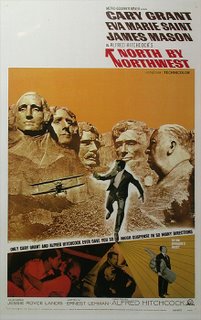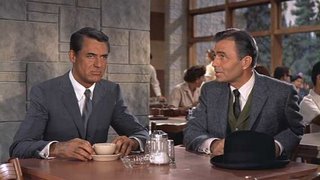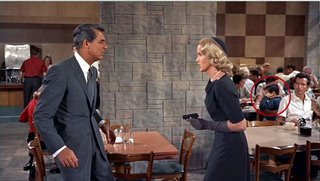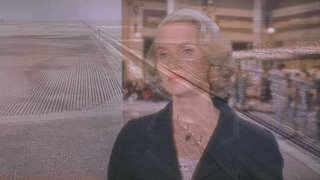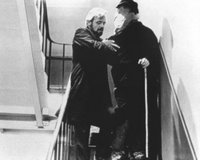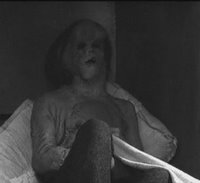If you didn't already know, Dennis over at
Sergio Leone and the Inside Fly Rule is having another one of his great quizzes. Consider these my answers, which I've also posted in the comments section of said quiz.
1) What was the last movie you saw, either in a theater or on DVD, and why?Last night, I watched
Videodrome on the Criterion DVD. I felt I owed it to myself, since I loved
A History of Violence so much and hadn't seen any other Cronenberg works.
2) Name the cinematographer whose work you most look forward to seeing, and an example of one of his/her finest achievements.From what I've seen, I love the work of Peter Suschitzky. In particular, I'd like to single out his work on
Lisztomania, a movie that wouldn't be nearly as wonderfully surreal if it weren't for Suschitzky's angles.
3) Joe Don Baker or Bo Svenson?Joe Don Baker seems like he'd be a nicer guy in person. And he wasn't in
Speed 2. That's an automatic strike against Svenson.
4) Name a moment from a movie that made you gasp (in horror, surprise, revelation…)Near the very end of
The 39 Steps, I gasped when I realized what was going to happen. Richard Hannay is back in the Music Hall, and he comments on the music. He's about five seconds behind me, but in those five seconds, I gasped. The girl sitting next to me laughed at me, but I was still satisfied with what Hitchcock could do to me.
5) Your favorite movie about the movies.Sunset Boulevard is the ultimate Hollywood movie. Because if you're not William Holden, then you're Joe Gillis. And if you
are William Holden, it won't be too long until you're Norma Desmond.
6) Your Favorite Fritz Lang movie.M is one of those achievements that make the coming of sound so worthwhile. Well,
M and Richard Linklater.
7) Describe the first time you ever recognized yourself in a movie.I can't help it. The girl I was after at the time looked a lot like Virginia Madsen. I was this elitist going through a period of self-discovery (still working on that one). I couldn't help but see myself in
Sideways' Miles Raymond. I'll be better next time.
8) Carole Bouquet or Angela Molina?Molina may have been in a remake of
Quo Vadis, but she was also in
1492. And Bouquet played Madame de . . . Point: Bouquet.
9) Name a movie that redeems the notion of nostalgia as something more than a bankable commodity.Rose-tinted glasses are a dangerous thing in films. I blame them for
Grease. But there are a pair that strike me as working both in spite of and because of their nostalgia. And they are the prefect analogues for their generations.
American Graffiti relives the notion of America before Kennedy, of that unspoiled time of life when kids could while away their time by driving down Main St. without feeling like the world could do them any harm.
Dazed and Confused looks at the world after the fall. Kennedy (both of them), MLK, Vietnam, Watergate, this is a time when hope is beginning to spring anew. There's a certain hope in those Aerosmith tickets. Maybe the 80's won't be so bad.
10) Favorite appearance by an athlete in an acting role.I think I have to go with, by default, OJ on the boat in
The Naked Gun. It's a moment of unceasing brutality made even funnier in retrospect because of what he's become.
11) Favorite Hal Ashby movie.Is there any question?
Shampoo. Pure 70's.
12) Name the first double feature you’d program for opening night of your own revival theater.I think I'd make a double feature featuring two very different views of the American Dream. First, I'd have
The Godfather to see the dark side. But then I'd follow it up with
Modern Times. We don't know what lies down that road, but if the Tramp's got his girl, then everything's going to be alright.
13) What’s the name of your revival theater?The Brattle. I love it so much. They're doing a Marx Brothers Marathon for New Year's Day.
14) Humphrey Bogart or Elliot Gould?Elliot's a nice guy and all, but there's still that scene in
The Maltese Falcon where he's walking out of Gutman's hotel room. The one when he just threatened Gutman, and now he trying to laugh it off, but his hand is shaking in fright. So good.
15) Favorite Robert Stevenson movie.Though I do love me some
Bedknobs and Broomsticks, and
Darby O'Gill and the Little People holds a special place in my heart, the uncontested crown goes to
Mary Poppins. I wish she was able to come into my life riding an umbrella and fix all my problems . . . sigh . . .
16) Describe your favorite moment in a movie that is memorable because of its use of sound.I love the abject fear that that whistle can induce in you in
M. There shouldn't be anything frightening. It's just a man whistling, right? And yet the whistling is so clear, precise, and
shrill. This is the whistle of a man who isn't like everyone else. His whistling is too perfect. It's just scary.
17) Pink Flamingoes-- yes or no?Umm . . .I believe that dog shit is for the next table, thank you.
18) Your favorite movie soundtrack score.I'm sorry, but the kid in me loves the Imperial March way too much to ever let it go,
Fargo and
Taxi Driver.19) Fay Wray or Naomi Watts?I seem to be the only one who thinks that Fay Wray is the most overrated part of the original
King Kong. I much prefer Robert Armstrong's lovably charismatic Carl Denham.
I fell asleep during the new
King Kong, but that's not Watts' fault. It's Peter Jackson's fault. And Watts was simply great in
Mulholland Drive. Point: Watts.
20) Is there a movie that would make you question the judgment and/or taste of a film critic, blogger or friend if you found out they were an advocate of it?Not really. For a while, I thought that might be
Moulin Rouge!, but it turns out that I still appreciate people's taste, even if they like it. And Ewan McGregor still can't sing.
21) Pick a new category for the Oscars and its first deserving winner.Yeah it's cliched, but I want a Best First Feature Oscar. Let the world know who's coming up in the world. And I think I need to give it to the one that really deserves it:
Brick.
Little Miss Sunshine, well, let's just say that's not my bag, baby.
22) Favorite Paul Verhoeven movie.Nothing quite like the coed showers in
Starship Troopers.
23) What is it that you think movies do better than any other art form?Movies have the unique ability to make that which is usually inaccessible to so many accessible. They can literalize emotions in the angle of a camera and the face of an actor. They can paint a beautiful picture, destroy the same image, and create another one just as beautiful, all in one instant. They can hold all the beauty in the world and let everyone else see too.
24) Peter Ustinov or Albert Finney?I'll have to take Finney. He looks like he has more fun during his films, even ones like
Erin Brockovich.25) Favorite movie studio logo, as it appears before a theatrical feature.I like the Focus Features logo. It uses such basic visual principles, yet seems entirely modern. I love the lion and the spotlights of Fox, but the blurry O just works so simply.
26) Name the single most important book about the movies for you personally.Hitchcock: The Murderous Gaze by William Rothman taught me the importance of ever single shot in a film. It also elevated Hitchcock to a whole new level for me. Indispensible in my film library.
27) Name the movie that features the best twist ending. (Please note the use of any “spoilers” in your answer.)I'm partial to the revelation of Keyser Soze in
The Usual Suspects. The juxtaposition of the quotes from earlier in the film with the images not only shows us who Keyser is and how he did it, but just how incredibly clever he was from the start. It's an absolute marvel to watch that ending unfold and be flabbergasted.
28) Favorite Francois Truffaut movie.My favorite Truffaut "movie" is
Antoine et Colette. It is one of the most painful moments on film, if only because the horribly awkward moments are more organic and less contrived that its later descendents. After all, who hasn't tried desperately to get that girl, only to find that she's actually taken? Thinking of the following moments in Colette's apartment with her parents still causes me to shudder.
29) Olivia Hussey or Claire Danes?Olivia Hussey was the voice of Kasan Moor in Star Wars: Rogue Squadron. Game, Set, Match: Hussey
30) Your most memorable celebrity encounter.I got my It Takes a Nation of Millions to Hold Us Back CD signed by Chuck D! And he gave a pretty cool history lesson, teaching us without us even realizing it.
31) When did you first realize that films were directed?Paths of Glory. No doubt about it. The battle scene, following Kirk Douglas as he works his way through No Man's Land was absolutely incredible for me. This was done unlike any other battle scene I can think of, in that it gave such slow, delicate camera movement. Up until that point, I just thought gun fire meant heavy editing and short shots. This showed that there was a way of breaking from generic cliches, and it showed me that movies were made by people.




